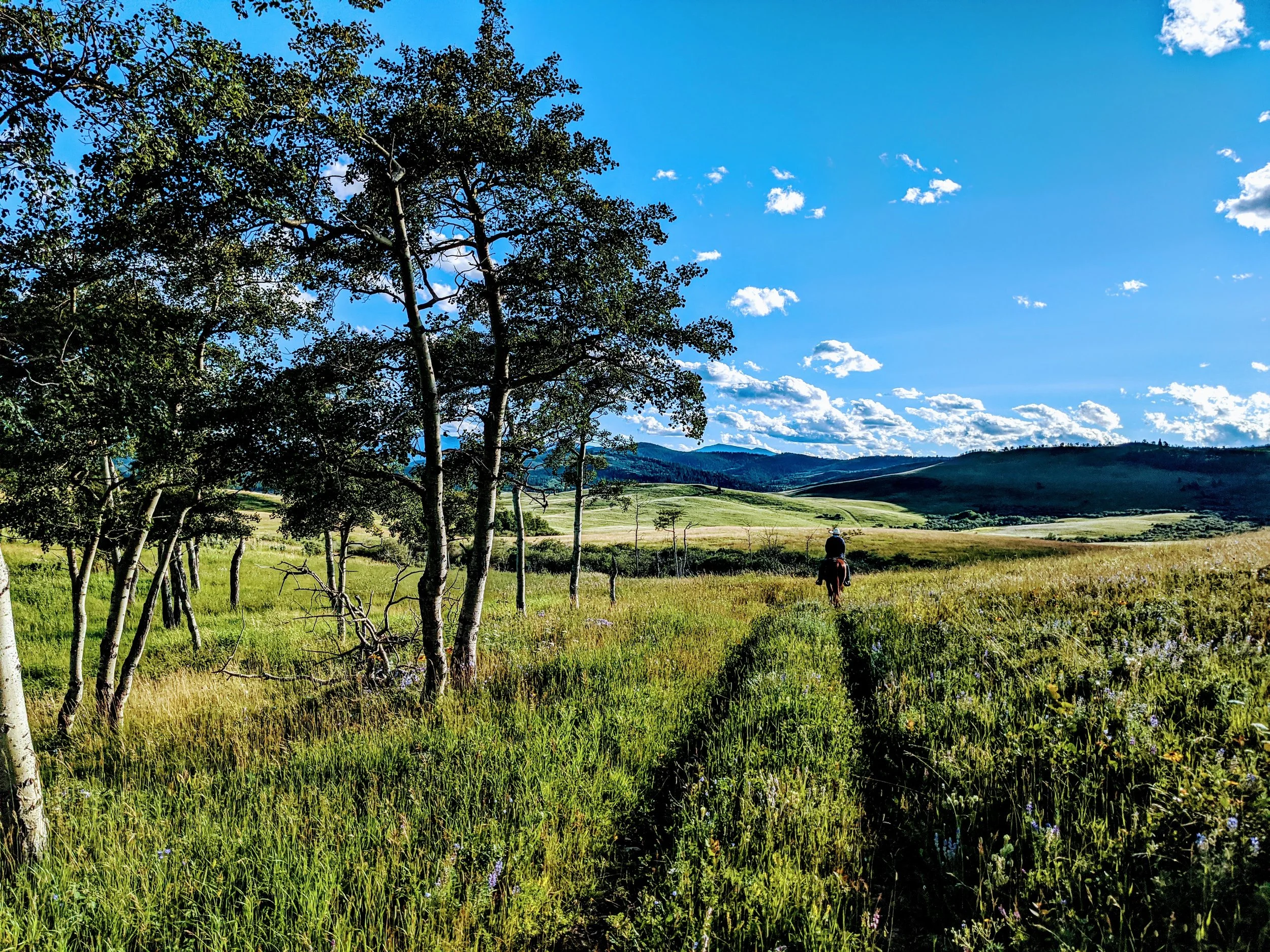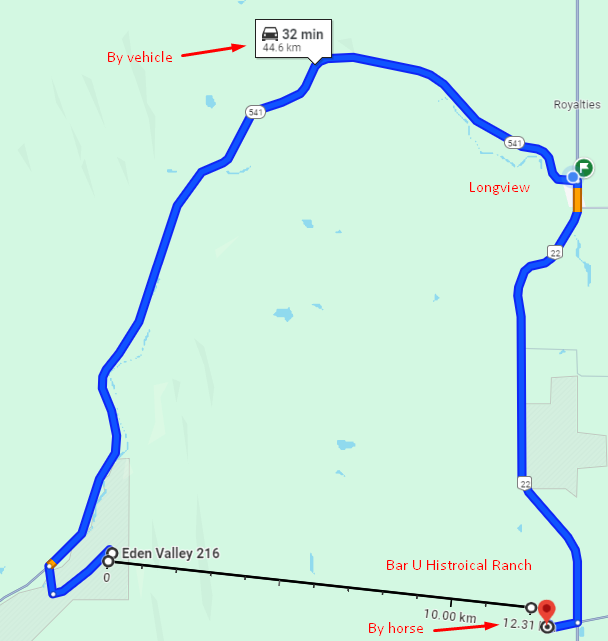10 Things I Learned from Joanne: Lesson 7
The Value of Estimating
This is the seventh article in a series called “10 Things I Learned from Joanne”.
In this article, I’ll explain what I learned from Joanne about estimating.
Joanne O’Connell is the co-author of the book that we recently published called Intentional Marketing: A Systematic Approach to Optimizing Performance.
Scroll down for a list of the other articles.
Photo by Jeff Nelson
Bar U Historical Ranch on Horseback
From Google Maps
I live in Longview. Eden Valley is about 30 minutes west. I have friends there with horses. A few years ago, my friend Wayne Wesley and I decided to ride from his home to Bar U Historical Ranch.
By the highway, this trip is about 45 km. But that is too boring. To have an adventure, we decided to go on horseback. Not just by horse but cross-country — the old way — through passes (beautiful), over ranch land (with cows, bears, and deer), through fences (we untied and tied up), and through muskeg (as we soon found out).
On a good day, on a good trail, with a good rider, a horse can travel about 7 km per hour. This trip is about 13 km as the crow flies. Over rough ground, we estimated the trip to be about 25 km. I got the information for my “estimate” from Google. So about 3 hours. Add an hour to let the horses rest, drink water and chew on the tasty grass. All told the trip to Bar U should be 4 hours max. An hour for lunch. 4 hours back. For a total of 9 hours. Easy.
As you have probably guessed, our estimate was wrong. It should be no surprise but it was a painful lesson — the trip took 13 hours. The ride there was 6 hours, a couple of hours resting, and 5 hours back. I don’t ride often, so after 11 hours in the saddle, I had a very sore butt.
As I look back, our estimate was off by nearly 50%. Here is a list of some reasons for our miscalculation:
Three others decided to join us for the trip which slowed us down
While riding, my horse decided to lie down at least 3 times (I thought that “Stumbles A Lot” was trying to kill me but Wayne said that the horse was just tired and wanted to go home. No surprise — I would dump someone off my back after a few meters.
None of us (not even Wayne or his brother, Darrel) had been on this trip in 20 years
We didn’t know where we were going. We never got lost but we did a fair amount of wandering around
On the way there, we took the “low road” and encountered a few creeks and lots of muskeg
The return trip from Bar U Ranch to Eden Valley took only 5 hours. The most important factor for taking less time on the way home was the decision to take the “high road”. The advantages included:
A better view of the terrain (see photo above)
Dryer terrain at upper elevations and less quagmire to navigate around
Using a “road” of sorts. It was more like a path but much easier to follow
Encountering fewer fences and more gates (much easier to open and close)
Experiencing the terrain for the second time
The Value of Estimating
My natural tendency is to get lost in the weeds. I like to figure things out for myself. I tend to be a perfectionist; usually about things that are important to me (but may not be to others).
At times, my attention to detail (which isn’t consistent) and my “perfectionism” (also not consistent) are annoying to the people who work with me. Most of the time I’m not even aware of their annoyance. I’m just happily swimming in sh*t, flopping around, and sinking to the bottom. Until I start gulping for air. Eventually, I lift my head out of the mire and see a few people yelling at me and trying to throw me a lifeline. I wish this had only happened once in my life, or only once a year, but sadly it seems to happen all the time.
It seems that I am who I am. I can change — a little — but not too much. Often when I try to change (too fast or too much) I get off balance and end up in the swamp anyway; usually farther out and deeper.
There is value in paying attention to details because details matter. Mistakes can be made. The measures (data) collected can be incorrect. The formulas for metrics can be wrong.
The trick I have found is timing. Sometimes focusing on details is valuable. At other times, climbing out of the swamp of details to a vantage point is important.
What I learned from Joanne is that estimating involves thinking and asking questions. By Joanne’s standards, this means doing a lot more thinking and asking many questions than I do naturally. I have to consciously set time aside to think and develop questions. I’m getting better. Practice helps.
Conclusion
Looking back on my horse riding trip to Bar U Ranch, I can see that I should have spent more time thinking and asking questions. I do estimates all the time — quick ones. More often than not I don’t take enough time at the beginning of a project to think. I tend to take a quick look and then charge ahead. In an emergency, reacting quickly is an advantage. But for most projects and tasks, a quick reaction is rarely an advantage.
Estimating is standing on a hill and looking around.
Estimating is looking down at the valley and seeing that the path is to the side and above the swamps.
Estimating is important at the start of a trip, project, or task.
Estimating involves looking at something and asking relevant questions.
It takes more effort but the effort is worth it. Better estimates help me with:
Expectations
Planning
Forecasting
Budgeting
Thanks Joanne.
Past Articles
The other articles are posted on the Anduro Blog.
Lesson 1: Each Level of the Model Must be Measurable
In the first lesson, I learned that each level of the marketing and sales model must be measurable. Joanne’s logic is that if you have a level in the model with no measurement, why bother with the level? I agree, wholeheartedly.
In the second lesson, I learned the difference between a measure and a metric. Read the article to discover Joanne’s genius and the magic between collecting and calculating.
In the third lesson, I learned that the basic components of marketing are simple but need to be in “alignment”. You need a product that solves a problem, a market that wants the problem solved (and is willing to pay for the problem-solving product), and a series of marketing activities that connect the market with the product.
Lesson 4: Inside vs Outside the Model
In the fourth lesson, I learned that Joanne distinguishes between “inside the model” and “outside the model”. This simple but not-so-obvious concept helps to simplify marketing and make it less overwhelming.
Lesson 5: The Stupidity of Ignorance
In the fifth lesson, I learned that people who design and develop a model of what is happening in marketing are much better able to see what is happening. In other words, they move from a position of ignorance to a position of understanding and enlightenment. In a nutshell, Joanne says, “People can do better.”
Lesson 6: Classifying Situations
In the sixth lesson, I learned from Joanne that from a high level, there can be issues with the product, the market, or marketing – or any combination of these. Classifying your company’s situation is the next step. In short, there are only a few situations that make logical sense.


